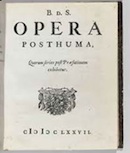
The history of the Short Treatise on God and Man and His Well-Being
Source: Spinoza's Short Treatise on God, Man and His Well-Being: Translated and Edited, with an introduction and commentary and a life of Spinoza by A. Wolf, 1910
(available at http://www.archive.org/stream/spinozasshorttre00spinuoft/spinozasshorttre00spinuoft_djvu.txt)
 "In 1703 after researchers had interviewed Spinoza’s friend Rieuwertsz in Amsterdam they reported that they had seen a manuscript in Spinoza’s handwriting and thought it was Spinoza‘s first, Dutch version of the Ethics.
"In 1703 after researchers had interviewed Spinoza’s friend Rieuwertsz in Amsterdam they reported that they had seen a manuscript in Spinoza’s handwriting and thought it was Spinoza‘s first, Dutch version of the Ethics.
It was quite different from the published Ethics not worked out in the geometric method, but in the ordinary way, and divided into chapters, like the Tractatus Theologico-Politicus Rieuwertsz assured them that the printed Ethics was very much better than this manuscript version, though the latter contained some things which were omitted from the former, notably the chapter on the Devil.
Several friends of Spinoza, said Rieuwertsz, had copies of that manuscript, which had never been printed because the Latin version, which had been published, was altogether superior and had been well edited.
Spinoza had such an evil reputation among respectable scholars that there was no anxiety to discover or recover any of his unpublished works, the published ones being considered more than enough.
In 1851 Edward Boehmer, Professor of Philosophy at Halle, went to Holland, also in search of Spinoza rarities. At Amsterdam he bought from F. Miller, a well-known bookseller there, a copy of the Life of Spinoza by Colerus.
Section 12 of Colerus Life of Spinoza treats very briefly of the philosopher’s unpublished writings, and Boehmer’s copy had a manuscript note (in Dutch) to this section, saying that among certain votaries of philosophy there was still extant, in manuscript, a treatise of Spinoza, which treats of the same subjects as the printed Ethics, though not in the geometric method, and that its style and general drift show it to be one of the earliest of Spinoza s writings,
In fact the first draft of the Ethics, and for some people less obscure than this, just because it is not cast in the geometric form. And at the end of the same copy of Colerus Life of Spinoza there actually followed a fairly complete analysis of the Short Treatise, chapter by chapter, and written in the same hand as the note to section 12.
Boehmer published his Benedicti de Spinoza Tractatus de Deo et Homine ejusque Felicitate Lineamenta in 1852, and a new impetus was given to the search for the Short Treatise. Not long afterwards a manuscript copy of the Short Treatise itself came to light. F. Miller, the same bookseller from whom Boehmer had got his copy of the Colerus, bought this manuscript of the Short Treatise at an auction.
And while Dr. J. van Vloten was preparing to publish it together with some Spinoza letters, a second (and older) manuscript of the Short Treatise was discovered. The poet, Adrian Bogaers, of Rotterdam, found it among his books. This (the older) manuscript is generally referred to as codex A, the other as codex B.
The first edition of the Short Treatise was published, in 1862, by Dr. ]. van Vloten in his Ad Benedicti de Spinoza Opera qucz Supersunt Omnia Supplementum. It was based on both the manuscripts, and was accompanied by a Latin translation. A more careful edition of codex A was published in 1869 by Professor C. Schaarschmidt, of Bonn, and also by Van Vloten and Land in their editions of the complete works of Spinoza (1882, 1895.) Both manuscripts are now in the Royal Library at the Hague."
Comment:
It would seem that Spinoza wrote the Short Treatise and lent it to some friends who made copies of it. He then decided to recast the ideas into the geometric form of the Ethics we know today. Most probably he burnt the original manuscript.